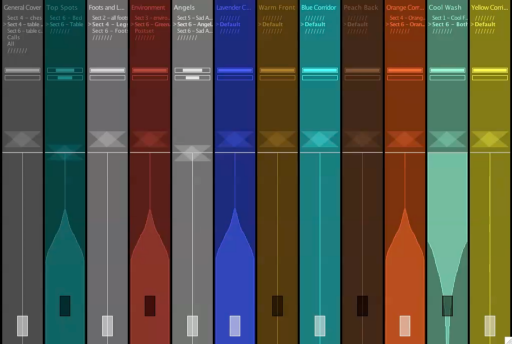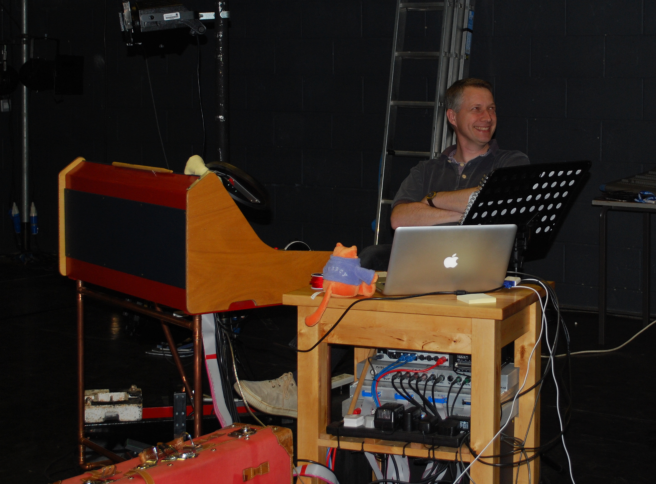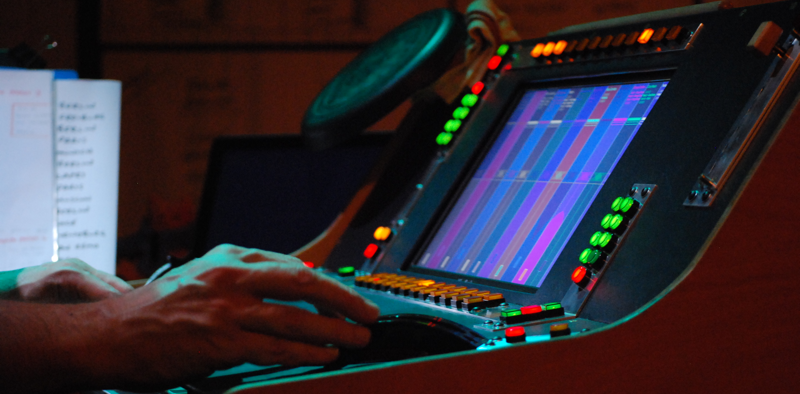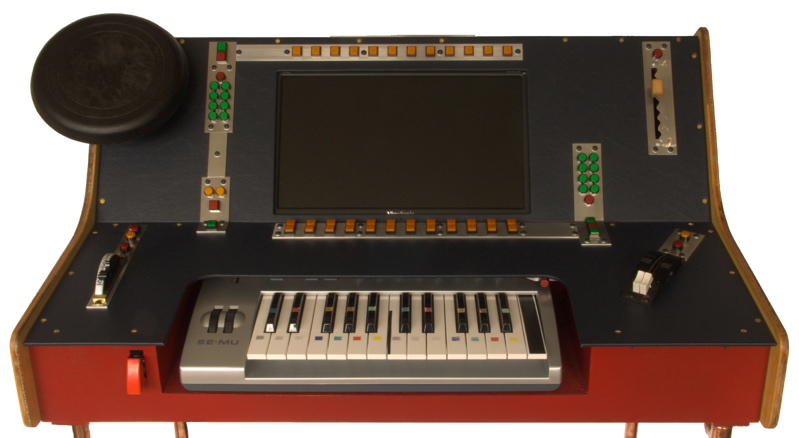Description
of
the Lighting Control Interface
[
Quick links: Home - A0
- A1
- A2
- A3
- A4 -
A5
- A6 - B0
- B1
- B2
-
B3
- B4
- B5
- B6
- B7
- B8 - B9
- B10
- B11
- B12
- B13
- B14 - B15 - B16
- C1
]
The design of my
lighting control interface – known as ‘Theolux’ – was primarily
determined by the two strategic interventions developed in chapter
II.3, together with pragmatic considerations such as the available
technology, budget, and my own craft and technical skills. Theolux
comprises hardware and software elements. All of the user controls
required for operation in performance are in hardware, while the
software handles all the data processing, and – via a conventional
computer graphical interface – provides the controls for setting
up the
system and for the ‘service’ functions, such as backing up data.
Technical details relating to the system architecture, protocols
and
proprietary equipment and software used can be found in appendix
A5.
The lighting
data structure used by Theolux is based on the threading model I
describe in chapter II.3. Prior to rehearsal or performance the
lighting artist can set up a series of threads, each of which
corresponds to a lighting affect. These threads may have one or
more
forms or ‘morphs’, and the lighting artist can change the
currently
active morph of a thread as required during the performance. For
example, a thread may be for side-lighting in a particular shade
of
blue; this will be the same throughout the performance, but at
different times that particular affect may be required in
different
areas of the stage. Morphs allow different combinations of blue
side-lighting luminaires to be used at different times, according
to
where the affect is required. The affect of the thread remains the
same, however – only its spatial location changes. Each morph may
contain lighting data for any or all of the lights in the rig, at
any
intensity level. Thus a morph is similar to a lighting cue state
or
‘picture’ as found in conventional theatre lighting controls in
that it
is a set of lighting data that determines the intensity of one or
more
lights, but typically only for a part of the rig. Generally more
than
one thread will be active at a time to build up the totality of
light
on stage at any given moment. Although my intention (in terms of
the
aims of my project) is that one thread corresponds to one lighting
affect, Theolux does not and perhaps could not enforce this. Thus
it is
for the lighting artist, in the rehearsal and performance process,
to
use the threads in the way intended (I discuss the relationship
between
threads and affects in practice in chapter III.1).
The threads
and
their morphs are created and where necessary edited prior to
rehearsal
or performance, using an interface similar to that found on
conventional theatre lighting controls, presented on the computer
screen and controlled via the computer’s keyboard. Once in
rehearsal or
performance, the Theolux hardware provides controls to allow the
lighting artist various ways to change the overall intensity of
each
thread (and so of the luminaires it contains), and to determine
which
is the active morph of each thread. A display screen shows the
status
of all of the twelve threads as vertical-running timelines
indicating
the current intensity of each thread, and any recent changes of
intensity. Each thread’s timeline also shows a list of the
thread’s
morphs, and the progress of the fade between morphs when such a
change
is happening. Below is a still image of the display screen, and a
video of the display screen content captured during the examined
performance can be found in appendix B4.
A
more detailed description of
the various visual elements on the display screen can be found in
appendix
A3.
 (click
for
larger
image
in
a
new
window)
(click
for
larger
image
in
a
new
window)
The controls
to
manipulate the morphs and threads are divided into three groups:
the
Morph Controller, the Impulse Controller and the Chord Controller
(see
the image below and appendix
A2).
The Morph Controller is used to trigger a
fade to the next morph in the list for selected threads. Buttons
along
the top of the main display screen select threads, and a ‘go’
button
triggers a fade to the next morph for all the threads selected,
with
the fade happening in a time pre-set when creating each morph.
Additional buttons can be used to stop or reverse the progress of
a
running fade, and to move forwards or backwards through the list
of
morphs, while a foot pedal provides an alternative means of
triggering
the fade when the lighting artist’s hands are busy with other
actions.
For the most part, the Morph Controller uses interface idioms that
are
well established in existing theatre lighting controls.
The Impulse
Controller provides a ‘select and play’ syntax for changing the
intensities of threads. The threads that the lighting artist
wishes to
control are selected on two rows of buttons below the main
display; the
top row is for selecting threads that will increase in intensity,
and
the bottom row is for selecting threads that will decrease in
intensity.
Once
selected,
the lighting artist may choose from one of several sub-controllers
to
control the change of thread intensity: the Crossfade Pair, the
Texture
Lever, the Big Lever, and the Pad. The Crossfade Pair is a pair of
hand-sized quadrant levers, one for the threads increasing in
intensity
and one for those decreasing. This sub-controller is intended to
afford
subtle and accurate control through levers gripped delicately by
the
lighting artist’s forefingers and thumbs, one hand for each fader.
Having two faders means that those threads increasing in intensity
and
those decreasing can move at different rates and have different
start
and finish times. The Crossfade Pair is similar in principle and
action
to the master crossfaders once found on preset manual desks before
the
introduction of automated crossfading and the ‘go’ button. The
Texture
Lever uses profiled metal plates against which the lever moves to
provide varying mechanical resistance to movement, resulting in a
‘textured’ or uneven movement of the fader and so of the change of
thread intensity over time. The Big Lever is a long-throw
floor-mounted
lever placed next to the main Theolux console, and requires the
lighting artist to use arm, shoulder and upper-body movement to
move
the lever through its full travel. A gas spring provides a
resistance
to movement in one direction that is approximately constant
throughout
the travel of the lever, and returns the lever to its starting
position
when the lever is released. The Pad is a percussive device that
can be
hit by the lighting artist with a drum stick to trigger an
instantaneous change of thread intensity either to maximum or to
zero,
depending on whether the thread is selected to go up or down in
intensity. The lighting artist can choose which sub-controller to
use
via a select button on each controller, with the exception of the
Pad,
which is always active. In summary, the Impulse Controller affords
the
lighting artist a variety of sub-controllers that have different
physical actions and so different intended aesthetic qualities in
terms
of the lighting change produced. Selected threads change intensity
either upwards or downwards in synchrony, starting and finishing
at the
same time.
The Chord
Controller is somewhat different, in that it allows the lighting
artist
to start and stop changes of thread intensity independently for
each
thread. A conventional two-octave musical instrument keyboard
provides
the principal control interface, with each of the twelve keys of
each
octave corresponding to a thread. Holding down a key in the
left-hand
octave starts the relevant thread increasing in intensity, while
holding down a key in the right-hand octave starts the thread
decreasing in intensity. In either case the speed, which is
between
instant and several minutes for full travel from zero to maximum
intensity, is determined either by a fader or by a foot pedal.
Releasing the keyboard key stops the change of intensity of the
thread,
leaving its intensity at its current value. By using a ‘chording’
action with several fingers of two hands, the lighting artist can
control combinations of threads with different start and finish
times
(although they all change intensity at the same rate). In
practice,
keys can be held down while the speed pedal is in the up or ‘off’
position, and then the speed pedal used rather like the
accelerator
pedal of a car, to increase the rate of change of intensity. As
the
desired intensity is approached, the speed can be reduced, or
individual threads ‘parked’ at their current intensity by
releasing the
relevant key while other threads continue to change intensity. A
further option is provided by a button to select Physics Mode;
when
selected, the speed pedal acts as an accelerator, and a second
pedal as
a brake. Once ‘moving’ (changing intensity), threads continue to
move
as if they had inertia, until the brake pedal is used to slow
their
change of intensity.
The above
description of the Theolux console systematically focuses on its
functions. We might usefully also remember here that the operation
of
lighting in performance is a situated, embodied act – a matter
that is
central to my thesis.

Above is a
photograph of the console during rehearsals, and as well as
showing the
layout of the various elements of the console (the main console
unit;
the auxiliary wing, nearest the camera, containing the electronics
and
supporting the notebook computer; a music stand to hold cue sheets
and
notes; the Big Lever just visible behind the main console), the
image
also suggests the messy happenstance of rehearsal and operation.
Technical, systematic descriptions, including those presented
above, tend to exclude the miscellaneous paraphernalia
that
this photograph reveals: the Post-It notes, the straggling cables,
the
stage weight temporarily securing the Big Lever, the reel of cord
used
as part of the set, the soft toy mascot, the ladder against the
wall. I
present this image here both to give a sense of the arrangement of
the
component parts of the console that I have already described, but
also,
and perhaps more importantly, to point to what technical
descriptions
otherwise tend to omit or efface – the detailed, messy specifics
of the
pragmatic, lived world.
I developed
the
Theolux console in several stages. The first stage established the
software foundation, providing both the underlying computer code
and
the software user interface to store, manipulate, save and load
the
lighting data. Following this, I developed the design for the
hardware
interface, but before constructing it I created a ‘virtual’
software
version of the hardware. The virtual hardware allowed me both to
test
and debug the main software, and also to refine the design of the
hardware before committing to building it. I tested this entirely
software version of Theolux in a lighting laboratory environment
at
Rose Bruford College, which provided valuable experience of using
the
system to control lights and carry out typical lighting
operations. I
next constructed the hardware, and again tested it in the
laboratory
environment, which led to further refinements. The complete
design,
construction and development process spanned approximately two
years
prior to the performance project itself. Despite this long
development
period, some changes were made (to the software) during rehearsal
for
the performance, and further possible changes to the design of
Theolux
were identified but not implemented (matters I discuss further in
chapter III.2).



